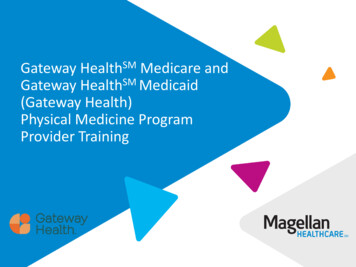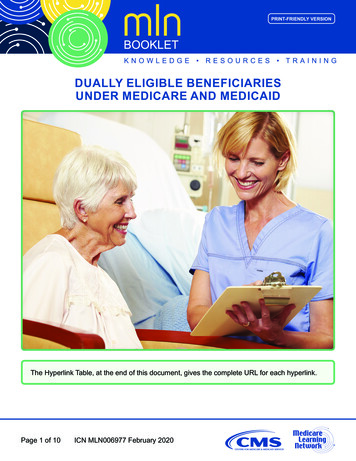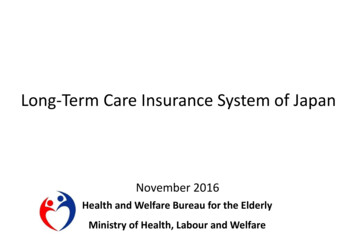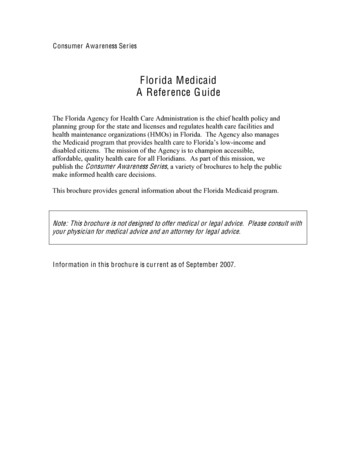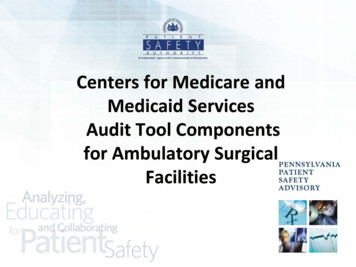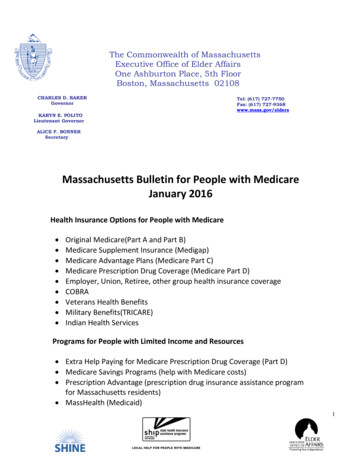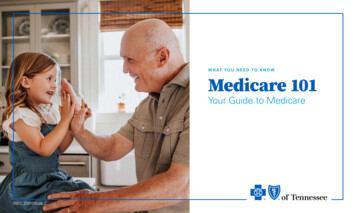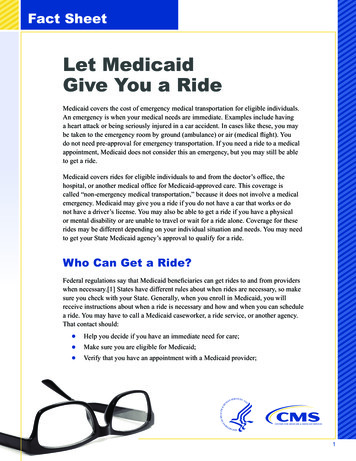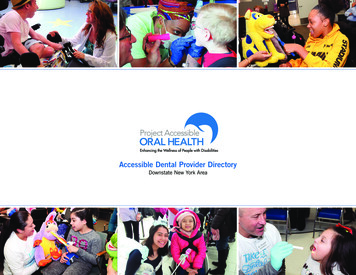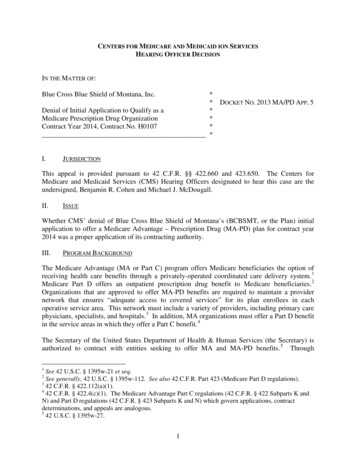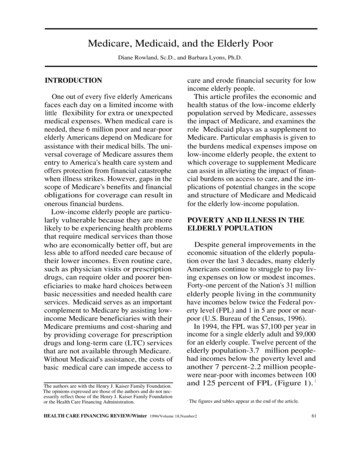
Transcription
Medicare, Medicaid, and the Elderly PoorDiane Rowland, Sc.D., and Barbara Lyons, Ph.D.INTRODUCTIONOne out of every five elderly Americansfaces each day on a limited income withlittle flexibility for extra or unexpectedmedical expenses. When medical care isneeded, these 6 million poor and near-poorelderly Americans depend on Medicare forassistance with their medical bills. The universal coverage of Medicare assures thementry to America's health care system andoffers protection from financial catastrophewhen illness strikes. However, gaps in thescope of Medicare's benefits and financialobligations for coverage can result inonerous financial burdens.Low-income elderly people are particularly vulnerable because they are morelikely to be experiencing health problemsthat require medical services than thosewho are economically better off, but areless able to afford needed care because oftheir lower incomes. Even routine care,such as physician visits or prescriptiondrugs, can require older and poorer beneficiaries to make hard choices betweenbasic necessities and needed health careservices. Medicaid serves as an importantcomplement to Medicare by assisting lowincome Medicare beneficiaries with theirMedicare premiums and cost-sharing andby providing coverage for prescriptiondrugs and long-term care (LTC) servicesthat are not available through Medicare.Without Medicaid's assistance, the costs ofbasic medical care can impede access toThe authors are with the Henry J. Kaiser Family Foundation.The opinions expressed are those of the authors and do not necessarily reflect those of the Henry J. Kaiser Family Foundationor the Health Care Financing Administration.HEALTH CARE FINANCING REVIEW/Wintercare and erode financial security for lowincome elderly people.This article profiles the economic andhealth status of the low-income elderlypopulation served by Medicare, assessesthe impact of Medicare, and examines therole Medicaid plays as a supplement toMedicare. Particular emphasis is given tothe burdens medical expenses impose onlow-income elderly people, the extent towhich coverage to supplement Medicarecan assist in alleviating the impact of financial burdens on access to care, and the implications of potential changes in the scopeand structure of Medicare and Medicaidfor the elderly low-income population.POVERTY AND ILLNESS IN THEELDERLY POPULATIONDespite general improvements in theeconomic situation of the elderly population over the last 3 decades, many elderlyAmericans continue to struggle to pay living expenses on low or modest incomes.Forty-one percent of the Nation's 31 millionelderly people living in the communityhave incomes below twice the Federal poverty level (FPL) and 1 in 5 are poor or nearpoor (U.S. Bureau of the Census, 1996).In 1994, the FPL was 7,100 per year inincome for a single elderly adult and 9,000for an elderly couple. Twelve percent of theelderly population-3.7 million peoplehad incomes below the poverty level andanother 7 percent-2.2 million peoplewere near-poor with incomes between 100and 125 percent of FPL (Figure 1). 1' The figures and tables appear at the end of the article.1996/Volume 18,Number261
Together, these 5.9 million poor and nearpoor people comprise Medicare's non-institutionalized low-income elderly population.Another 1.4 million elderly reside in nursing homes and receive assistance fromMedicaid (Lyons, Rowland, and Hanson,1996).The likelihood of living on a low incomeis greatest for women, minorities, and theoldest Americans (Figure 2). Poverty ratesincrease with age, with 23 percent ofpeople 75 years of age or over poor or nearpoor, in contrast to 16 percent of those 6574 years of age. Nearly one-fourth of elderly women are poor or near poor,reflecting their lower wage levels duringworking years, their increased risk of financial stress from widowhood, and longevity that exceeds savings. Elderly minorities are particularly vulnerable to lowincomes. Thirty-seven percent of black elderly people and 36 percent of Hispanic elderly people have incomes below 125percent of FPL.Poverty is clearly linked to educationallevel and highly correlated with maritaland living arrangements. Well-educated,married couples are financially better offthan those who are less educated, single,and living alone. Educational levels correspond to different job opportunities and careers, with the more highly educated likelyto have better retirement benefits andmore personal savings from their workingyears. Among today's elderly population,42 percent have less than a high schooleducation, but there are significant differences by income. Seventy percent of thepoor elderly, compared with 23 percent ofthe non-poor elderly, are without a highschool diploma (Figure 3).Marital status and living arrangementalso differ significantly by income, with 42percent of the poor compared with 21 percent of the non-poor living alone, and onlyone-third (31 percent) of the elderly poor62are married, in contrast to 72 percent of thenon-poor elderly. This reflects the olderage composition of the poor elderly (14 percent are over 85 years of age comparedwith 5 percent of the non-poor), and the tolltime, illness, and loss of a spouse can impose on an individual's economic well-being. Yet it also means that the poor elderlyare less likely to have family or companionsliving with them who can assist withmedical or financial needs.Medicare coverage is especially important to low-income elderly people becausethey are in poorer health than higher income elderly people and have few financialassets to draw on when faced with highmedical costs. Poor health status, multiplechronic conditions, and functional limitations are all more prevalent among the lowincome elderly population than amongthose with higher incomes. These conditions increase the need for and utilizationof medical services which in turn increasesthe out-of-pocket expenses for cost-sharingand uncovered medical expenses.The burden of illness is a serious problem for many poor and near-poor elderlypeople. Overall, one-fourth (24 percent) ofthe elderly population reports their healthstatus as fair or poor (Figure 4). Over onethird (36 percent) of the poor and nearlyone-third (32 percent) of the near-poor elderly report their health as fair or poor compared with only 17 percent of the non-poorelderly with incomes above 200 percent ofFPL. Poor health status has been shown tobe highly predictive of the need for medicalcare (Manning, Newhouse, and Ware, 1981).Chronic conditions requiring increasedcontact with the medical care system andongoing health care costs are more prevalent in the elderly population than in thenon-elderly population and can be particularly burdensome for low-income elderlypeople. All elderly people are at increasedrisk of chronic illness, but low-incomeHEALTH CARE FINANCING REVIEW/ Winter1996/Volume 18, Number 2
people are more likely to have chronichealth problems than non-poor elderlypeople (Figure 5). Nearly two-thirds (65percent) of poor elderly people suffer fromarthritis that can impair mobility and resultin the need for medication for treatmentand pain relief. Similarly, the prevalence ofdiabetes and hypertension, both illnessesrequiring substantial medication costs andongoing physician supervision, is highestin the low-income cohorts of the elderlypopulation.Functional disabilities contributing tothe need for LTC assistance further compound the medical problems of elderlypeople (Rowland, 1989). Among non-institutionalized elderly Medicare beneficiaries;7.8 percent report needing help to performone or more activities of daily living(ADLs), such as dressing, eating, andtoileting, and many more report difficultyin carrying out these activities due tohealth problems. The rates are higher forthe poor and near-poor elderly, with 12.9percent of the poor and 10.5 percent of thenear-poor reporting such limitations (Figure 6). Low-income elderly people are alsomore likely to have three or more ADLsand increased dependency because of multiple limitations than those with higher incomes. Elderly people with functional limitations are often financially strained bynon-medical needs and expenses as well asby the need for additional services and special transportation arrangements to obtainmedical care.In sum, poor and near-poor elderlypeople are more likely to be experiencinghealth problems for which they requiremedical services than elderly people whoare economically better off, but they areless able to afford needed care because oftheir lower incomes. For those who needmedical care and incur large out-of-pocketexpenditures, medical expenses can lead toHEALTH CARE FINANCING REVIEW/ Winterimpoverishment. The extent to which insurance is available to assist with medicalbills becomes a crucial factor.ROLE OF MEDICAREWith the enactment of Medicare in 1965,basic health insurance protection for hospital care and physician services was extended to nearly all elderly Americans. Theuniversal nature of Medicare coveragemeans that virtually no elderly person iswithout insurance. Medicare facilitates access to physician services and guaranteesadmission to a hospital when needed. Itmeans that coverage for the elderly doesnot vary by State of residence and does notlimit the elderly's choice of providers in themainstream of American medical care.Over its 30 years of operation, Medicarehas provided elderly Americans, and especially poor elderly Americans, with the opportunity to benefit from the many advances of American medical technology,most notably treatment for heart diseaseand cataract surgery, and to gain improvedaccess to the health care system (Madansand Kleinman, 1980; Davis and Rowland,1986).Low-income elderly people have beenparticularly reliant on Medicare coveragebecause they are in poorer health thanhigh-income elderly, and therefore, aremore likely to use health services. Although Medicare provides basic health insurance to promote access to care, it is notan all-inclusive comprehensive and freemedical plan for the elderly poor and nearpoor. Financial concerns can still impedeaccess to needed medical care, especiallyfor those who have the most health needs.Medicare beneficiaries in poorer healthare more likely to report barriers to carethan beneficiaries with better health(Rosenbach, Adamache, and Khandker, 1995).1996/Volume 18, Number 263
Some of the financial burdens for carestem from the design and scope of theMedicare benefit package. Modeled afterprivate insurance coverage for the non-elderly population, Medicare has substantialcost sharing requirements and financial obligations for beneficiaries. The hospital insurance (Part A) component providesfairly extensive coverage of short-term hospital care and some coverage of post acuteskilled nursing facility and home healthservices. The supplementary medical insurance (Part B) component of Medicarecovers physician care and related ambulatory services and home health visits. Medicare requires beneficiaries to pay a premium for coverage under Part B, adeductible for hospital care under Part A,and a deductible and 20 percent coinsurance for most physician and ambulatorycare services under Part B (Table 1).For many elderly people, Medicare thusprovides essential, but incomplete, protection against medical expenses. In additionto the required premiums and cost sharing, Medicare's benefit package does notcover the full range of health servicesneeded by many elderly people. Particularly absent from the Medicare benefitpackage is coverage of outpatient prescription drugs, vision care, and dental services. In addition, Medicare does not coverchronic LTC needs, most notably nursinghome care for the disabled elderly (Federand Lambrew, 1996).Out-of-pocket spending on acute caremedical services and insurance premiumsfor both Medicare and private supplemental policies are significant expenses in thebudgets of elderly Americans (Moon andMulvey, 1996). The average dollar amountof out-of-pocket spending increases with income, averaging 1495 in 1994 for nonpoor elderly and 913 for poor elderlypeople (Figure 7). The lower level ofspending by low-income elderly people64reflects both their limited financial abilityto pay substantial amounts and the likelihood that some of the low-income elderlyare assisted with their medical expensesand premiums by Medicaid. Although thepoor elderly spend a lower dollar amounton out-of-pocket medical expenses thanhigher income elderly, that spending constitutes a much larger share of the overallincome of the poor. Health expendituresfor acute care services and premiums bythe elderly represent one-third of thefamily income of poor elderly people compared with 16 percent for non-poor elderlyfamilies (Figure 8).To provide assistance with cost sharingand additional protection, most elderlypeople have private insurance and/or Medicaid coverage to supplement their Medicare coverage (Figure 9). In 1992, 81 percent of Medicare's elderly beneficiarieshad private supplemental insurance, oftencalled medigap insurance, in addition toMedicare. An additional 9 percent of elderly beneficiaries received assistance fromMedicaid because of their low incomes.However, 10 percent of Medicare beneficiaries had neither Medicaid nor private insurance to supplement Medicare. Forthese Medicare-only beneficiaries, any expenses uncovered by Medicare are out-ofpocket liabilities.The pattern of insurance coverage variessignificantly by income. Private insuranceto complement Medicare is most commonamong the elderly non-poor population andless extensive as a form of financing forthose with lower incomes (Figure 10).Among the elderly poor, over one-third (36percent) have Medicaid supplementarycoverage, 46 percent have private medigappolicies, and 18 percent rely solely onMedicare. For the near-poor elderly, private insurance coverage is more extensive,with 64 percent privately insured. Amongthe near-poor elderly, 15 percent haveHEALTH CARE FINANCING REVIEW/Winter1996/Volume 18, Number 2
Medicaid coverage and 21 percent relysolely on Medicare, reflecting the lowerpenetration of Medicaid coverage for thenear-poor population.Affordability of private insurance policies to supplement Medicare is a majorbarrier to coverage for many low-incomeelderly beneficiaries. Higher income elderly beneficiaries are much more likely tohave retiree benefits that provide health insurance coverage to supplement Medicare.Low-income people are less likely to havehad the types of jobs during their workingyears that offer private health insurance after retirement as a benefit. As a result,higher income elderly are more likely tohave employer-sponsored coverage, whilelow-income elderly are more reliant onmedigap coverage.An individually purchased medigap planin 1992 averaged over 1,000 (Chulis,Eppig, and Poisal, 1995). The high cost ofmedigap coverage results in a greater financial burden on low-income beneficiaries compared with more economicallyadvantaged elderly people. For a poor elderly individual living on an annual incomeof less than about 7,000, spending 1,000on a medigap policy can substantially strainresources. In recent years, Medicaid hashelped to fill this gap by providing assistance with Medicare's financial obligationsto low-income elderly Medicare beneficiaries, but the large share of both poor andnear-poor elderly people relying solely onMedicare for coverage underscores thelimits of Medicaid's reach.important source of health care financing.Medicaid will pay the Medicare Part B premium for Medicare beneficiaries with incomes below 120 percent of FPL plus theMedicare cost sharing for those with incomes below FPL. Elderly cash assistancerecipients and others covered at State option can also receive additional benefitsfrom Medicaid to supplement Medicare,including prescription drugs and LTCcoverage.In recent years, Medicaid coverage ofthe elderly has been expanded considerably to assist low-income Medicare beneficiaries with the growing cost of Medicarepremiums and cost-sharing. Most notably,as part of the Medicare Catastrophic Coverage Act of 1988, States were required byJuly 1992 to provide Medicaid assistancewith the Part B premium and Medicarecost-sharing to all elderly individuals andcouples with incomes below FPL and assets of less than 4,000 for individuals and 6,000 for couples. The individuals coveredunder this provision are referred to asQualified Medicare Beneficiaries (QMBs).The act also required States to phase in by1995 assistance with Medicare's Part Bpremium to individuals with incomes between 100 and 120 percent of FPL. For thisgroup, known as Specified Low-IncomeMedicare Beneficiaries (SLMBs), assistance is limited to the premium payments.States are not required to provide eithergroup with wrap-around benefits tosupplement Medicare.The over 4 million low-income elderlypeople on Medicaid qualify for assistanceby various routes, as shown in Figure 11.Over one-half of the elderly with Medicaidcoverage obtain eligibility as "categoricallyneedy" because they are recipients of cashassistance or eligible for assistance underthe Supplemental Security Income program. Other individuals are covered at theoption of the State as "medically needy"ROLE OF MEDICAIDMedicaid makes Medicare coverage affordable for over 4 million low-income elderly Medicare beneficiaries by serving astheir medigap policy. For those who qualifyfor assistance from the means-tested Medicaid program, Medicaid coverage is anHEALTH CARE FINANCING REVIEW/Winter1996/Volumeis,Number 265
eligibles. These individuals, accounting for20 percent of elderly Medicaid beneficiaries, have incomes above welfare cash assistance levels, but incur expenses forhealth services that reduce their availableincome to below the income standard foreligibility.Both the categorically needy and medically needy groups receive Medicaid benefits to complement Medicare's benefitpackage as well as assistance with Medicare premiums and cost-sharing. The elderly in nursing homes with Medicaid coverage are included in both the categoricaland medically needy groups. The QMB/SLMB beneficiaries with their coveragemainly for Medicare financial obligationsrepresent 13 percent of Medicaid's elderlybeneficiaries. The remainder of low-income elderly beneficiaries qualify for coverage under coverage provisions that are atState option.Despite Medicaid's important role inproviding protection for Medicare premium and cost sharing requirements,Medicaid spending on behalf of elderlybeneficiaries goes primarily toward coverage of more costly LTC services. In 1993,Medicaid spending totaled 125 billion, ofwhich 34 billion was spent on services forthe low-income elderly (Liska et al., 1995).One-fourth of this spending went towardsacute care services and Medicare payments, and the remainder was devoted toLTC spending on nursing homes and community-based services (Figure 12). In1993, Medicaid paid 2.7 billion to theMedicare program on behalf of low-incomeMedicare beneficiaries for premium andcost-sharing obligations and spent an additional 6 billion to supplement Medicare'scoverage of hospital and physician careand to cover other medical services, suchas prescription drugs not covered by Medicare. These expenditures for acute care66and Medicare premiums accounted for 7percent of total Medicaid spending.Medicaid thus plays a critical role in providing financial protection to low-incomeelderly people. However, the scope ofMedicaid's protection remains limited interms of the share of the poor and nearpoor population with coverage. Only onethird of the elderly poor and 15 percent ofthe near-poor elderly have Medicaid coverage despite the financial benefits of suchcoverage. Lack of awareness and understanding of the assistance Medicaid provides, complex enrollment processes, limited outreach activities by Federal andState governments, and reluctance to applyfor help from a welfare-linked program allcontribute to low levels of participation inMedicaid by the poor and near-poor elderly(Neumann et al., 1995).IMPACT OF INSURANCE ONACCESSThe level of insurance protection to alleviate financial barriers to care is clearly ani mportant element in securing access tocare for the low-income elderly population.Although Medicare coverage is universal,ability to pay for Medicare's cost-sharingrequirements varies for elderly people atdifferent income levels and with differentlevels of insurance supplementation. Lackof supplementary coverage through private insurance or Medicaid to fill gaps inMedicare coverage influences access tohealth services by elderly people. One-halfof the population that relies solely on Medicare are poor or near-poor and likely to experience financial burdens that jeopardizeaccess to care.Examining utilization of ambulatory careservices by income status and insurancestatus shows that Medicare coverage hashelped to reduce differentials in access toHEALTH CARE FINANCING REVIEW/ Winter1996/volume 18, Number 2
care by income, but differentials stillremain when variations in insurance aretaken into account. Those with Medicareonly coverage do not have comparable access to those with private or Medicaid coverage to supplement Medicare. Levels ofphysician services are comparable acrossincome groups and, currently, revealsomewhat higher use rates for the low-income population, reflective of their poorerhealth status (Figure 13). However, physician visits by insurance status, not controlling for income, show that the Medicareonly population has fewer physician visitsthan the privately insured and notablyfewer visits than those with joint Medicareand Medicaid coverage (Figure 14). Thehigher rates for the Medicaid populationreflect their higher rates of chronic illnessand disability.These statistics, however, combine theeffects of income and insurance coverageon utilization. Using Medicare spending asa proxy for health services utilizationshows lower levels of access for beneficiaries without supplemental insurance. Lowincome beneficiaries who rely solely onMedicare are less likely to use any Medicare covered services over the course of ayear. Among poor and near-poor Medicarebeneficiaries, 30 percent of those with onlyMedicare coverage received no Medicarereimbursement for services, comparedwith 17 percent of those with privatesupplemental insurance and 11 percentwith Medicaid (Figure 15).When access to care is assessed by insurance status and income level, it is apparent that to be low-income and covered onlyby Medicare is associated with accessproblems. Measures of access problems,including no usual source of care, difficulties in obtaining care, and lower satisfaction levels for particular aspects of care,are indicative of problems in gaining entryto the health care system and in usingHEALTH CARE FINANCING REVIEW/ Winterservices (Weissman and Epstein, 1993).Having a usual source of care, or a particular place where care is obtained, is commonly viewed as an indicator of access tomedical care and an important componentof primary care. Low-income Medicarebeneficiaries who rely solely on Medicareare over twice as likely as those with additional coverage to be without a usualsource of care. Nearly one-fourth (22 percent) of Medicare-only beneficiaries reportno usual source of care compared with 8percent of those with private insurance and9 percent of those with Medicaid (Figure 16).Problems in obtaining care, such as delay in seeking care due to cost, provide direct evidence of the impact of financial barriers to care. Problems in obtaining caremay compromise health status and resultin prolonged suffering and increased morbidity. If care is eventually obtained and theproblem has become more severe, it maybe more difficult and costly to treat because of the delay. Low-income elderlyMedicare beneficiaries who have onlyMedicare are two times as likely to delayseeking needed medical care as those withadditional private insurance or Medicaid.One-fourth of low-income Medicare-onlybeneficiaries indicate that they delayedseeking medical care in the past year because of worry about the cost (Figure 17).In contrast, only 13 percent of those withMedicaid or private insurance reportedsuch delays due to cost. Having additionalcoverage substantially lowers the likelihood of problems in gaining entry to thehealth care system.Similarly, lower levels of satisfaction without-of-pocket costs reflects inadequate insurance coverage and can be indicative ofaccess problems. Over one-fourth (27 percent) of low-income elderly Medicare-onlybeneficiaries report that they are unsatisfied or very unsatisfied with the out-ofpocket costs they paid for medical care1996/volume IM, Number 267
(Figure 18). Those with private supplemental coverage also reported similar levels ofdissatisfaction. Highlighting the financialprotection Medicaid provides for the lowincome population, only 12 percent ofbeneficiaries who had Medicaid wereunsatisfied with out-of-pocket costs.In sum, Medicare has contributed substantially to the well-being of the elderly byfacilitating access to care and reducing financial burdens. The program providescoverage of medical care for virtually allelderly Americans, but Medicare's gaps incoverage and financial obligations are particularly difficult for poor and near-poorelderly people to handle. Medicaid plays anessential role in supplementing Medicare'scoverage and makes Medicare work formany low-income Medicare beneficiaries.However, Medicaid's assistance does notextend to all low-income elderly people;those who are left to rely on Medicarealone are at substantial risk for accessproblems.IMPLICATIONS FOR THE FUTUREThe three decades of experience withMedicare as a primary insurer and Medicaid as a supplement for the low-incomeelderly demonstrate the importance ofboth basic coverage for all elderly peopleand additional financial assistance for lowincome elderly people. For those in the elderly low-income population jointly coveredby Medicare and Medicaid, access to care,financial protection, and satisfaction withthe cost of medical care are all notablyhigher than for low-income elderly whodepend solely on Medicare. With the universal base of Medicare as a building blockfor health care coverage, the elderly poorand near-poor with Medicaid supplementation are able to access mainstream medicalcare without severe financial burden.68The partnership between Medicare andMedicaid has enabled millions of low-income Medicare beneficiaries to realize thefull potential of Medicare coverage, but theability to maintain and expand that partnership to reach more of the low-income elderly population is uncertain. Proposals toincrease financial obligations under Medicare or shift the program from a definedbenefit to defined contribution approachcould result in significant increases in beneficiary costs and undermine the adequacyof protection for the poorest beneficiaries.In the past, Medicaid coverage has beenused to fill in and compensate for changesin Medicare coverage. However, proposalsto convert Medicaid to a block grant toStates with a fixed and potentially reducedfederal contribution could restrict Medicaid's ability to serve as a Medicare safetynet. Such a shift in Medicaid's structurecould also jeopardize the continuation ofthe current level of coverage Medicaidprovides to low income Medicare beneficiaries.As the future of Medicare and Medicaidare debated, particular attention needs tobe given to the elderly poor. One in 10Medicare beneficiaries count on Medicaidto help with their medical expenses andMedicare financial obligations. Even withMedicaid assistance, the elderly poor devote one-third of their family income tohealth expenses. Low-income elderlyAmericans experience more health problems and have greater use of health services with the associated cost for treatmentand medication than higher income elderly. The 1 in 5 low-income Medicare beneficiaries without Medicaid to supplementMedicare are particularly at risk. Evenwith Medicare's basic protection, the costfor premiums, cost-sharing, and uncoveredservices can compromise access to care.To assure Medicare's adequacy forcoverage in the future, it is important toHEALTH CARE FINANCING REVIEW/ Winter1996/volume 18, Number 2
maintain assistance with financial obligations and additional benefits that Medicaidprovides today. It is critical to either maintain the Medicare-Medicaid partnershipfor the low-income elderly or to providedirect federal assistance to supplementMedicare for the elderly poor. Withoutsuch guarantees, Medicare's notableprogress in reducing gaps in service usebetween poor and non-poor elderly couldbe undone and millions of low income elderly Americans could have their access tomedical care compromised.ACKNOWLEDGMENTSThe authors greatly appreciate the research assistance of Patricia Seliger andKristina Hanson of the Kaiser Family Foundation and the computer programming assistance of Laurie Pounder of the UrbanInstitute.REFERENCESChulis, G., Eppig, F., and Poisal, J.: MCBS Highlights: Ownership and Average Premiums forMedicare Supplementary Insurance Policies.Health Care Financing Review 17(1):255-75, Fall1995.Davis, K., and Rowland, D.: Medicare Policy: NewDirections for Health and Long-Term Care. Baltimore, MD. The Johns Hopkins University Press,1986.Feder, J., and Lambrew, J.: Why Medicare Mattersto People Who Need Long-Term Care. Health CareFinancing Review 18(2):99-112, Winter 1996.Health Care Financing Administration: MedicaidStatistics: Program and Financial Statistics, FiscalYear 1994. HCFA Pub. No. 10129. Washington.U.S. Government Printing Office, 1996.Liska, D., Obermaier, K., Lyons, B., and Long, P.:Medicaid Expenditures and Beneficiaries: Nationaland State Profiles & Trends, 1984-1993. Report ofthe Kaiser Commission on the Future of Medicaid.Washington, DC. 1995.HEALTH CARE FINANCING REVIEW/ WinterLyons, B., Rowland, D., and Hanson, K.:
the out-of-pocket expenses for cost-sharing and uncovered medical expenses. The burden of illness is a serious prob-lem for many poor and near-poor elderly people. Overall, one-fourth (24 percent) of the elderly population reports their health status as fair or poor (Figure 4). Over one-third (36 percent) of the poor and nearly
